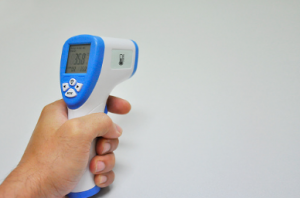Inspect Yourself With an Infrared Thermometer
An infrared thermometer is a measuring device that measures the temperature of objects by inferring it from thermal radiation, otherwise known as black-body radiation. This content will discuss the most common uses, Costs, and Error rates of infrared thermometers. Once you know an infrared thermometer, you’ll be ready to purchase one. But which one is right for you?
Disadvantages of infrared thermometers
 While a general-purpose infrared thermometer has an emissivity of 0.78, a fixed-emissivity thermometer will add up to five degrees of temperature to the forehead temperature. Because the surface of the forehead is five degrees lower than the internal body temperature, a fever is present at a temperature above 95F. Therefore, an infrared thermometer cannot give the correct temperature for a fever but can give you an accurate reading. For more information, visit https://www.instrumentchoice.com.au/instrument-choice/meters/environment-meters/ir-thermometers.
While a general-purpose infrared thermometer has an emissivity of 0.78, a fixed-emissivity thermometer will add up to five degrees of temperature to the forehead temperature. Because the surface of the forehead is five degrees lower than the internal body temperature, a fever is present at a temperature above 95F. Therefore, an infrared thermometer cannot give the correct temperature for a fever but can give you an accurate reading. For more information, visit https://www.instrumentchoice.com.au/instrument-choice/meters/environment-meters/ir-thermometers.
One of the main disadvantages of an infrared thermometer is its limited range of application. It is ineffective for measuring transparent objects’ temperatures because visible light can’t penetrate them. As a result, the device will measure the temperature of the window and not the actual object. It is not a big issue if you only plan to measure small objects. However, plan to use your infrared thermometer in a small area. It will be useless if it can’t measure the temperature of small objects, such as refrigerators and freezers.
Common uses
Infrared thermometers are commonly used to measure surface temperatures in different applications. If temperatures in certain areas are unusually high or low, they can be used to seal leaks and address poorly-insulated areas. The temperature difference between the interior and exterior of a wall is the best indication of insufficient insulation. This information can help prevent future building systems or mechanical equipment failures.
Besides their many health applications, IR thermometers are also helpful in the kitchen. They can be used to determine the temperature of food or cooking equipment without touching it. Firefighters use IR thermometers to locate hotspots in fires. In addition to their medical applications, IR thermometers are also used for industrial purposes, such as monitoring equipment in manufacturing plants and inspecting surfaces for elevated temperatures.
Cost
An infrared thermometer is a tool that measures surface temperature over a wide range. There are three main types of infrared thermometers: no-lens, mica-lens, and fresnel lens. The cost of these thermometers will vary depending on their optics. To understand which one is best for you, read on to learn more about the features of each type.
The EnnoLogic IR non-contact thermometer displays the maximum voltage with a steady beeping sound. This device is one of the most accurate thermometers on the market. It has a 10-year warranty and is easily transportable, even in a purse or pocket. It is the most affordable of the three and has the best features. For the price, it’s the best choice for most consumers.
Error rate
Among the three types of infrared thermometer, the clinical non-contact thermometer is most sensitive to temperature changes over a narrow range of temperatures. In contrast, the industrial IR thermometer is somewhat less sensitive and is meant for use at a longer distance. However, in both cases, the sensitivity level of the instrument will be much higher than the one obtained using the forehead thermometer.
An IR thermometer’s accuracy varies from a few hundred degrees Fahrenheit to several thousand degrees Fahrenheit. Although most thermometers come with the manufacturer’s specification for ideal operating and storage conditions, they are not perfectly accurate. Accuracy reduces in extreme temperatures, and a difference of 30deg F is insignificant compared to a temperature of 1000 degrees Fahrenheit. Infrared thermometers vary in accuracy due to several factors.
Distance from object to surface measured.
Infrared thermometers measure the temperature of an object’s surface using a distance-to-spot ratio. The ratio of the distance to the spot determines the accuracy of the measurement. The temperature is typically measured on a circular surface. However, the distance-to-spot ratio may be insufficient if using an infrared thermometer to detect temperature changes in a large area. For more information, visit https://www.instrumentchoice.com.au/instrument-choice/meters/environment-meters/ir-thermometers.
An IR thermometer’s maximum temperature readout is usually from a few hundred to several thousand degrees Fahrenheit. Manufacturers usually specify the accuracy in absolute terms and relative terms. An example infrared thermometer is accurate to three degrees F, but the accuracy decreases at higher temperatures, where the difference is insignificant. There are several things to consider when purchasing an infrared thermometer, but the most important considerations are the temperature range, D:S ratio, and emissivity functionality.
